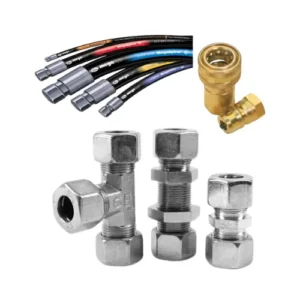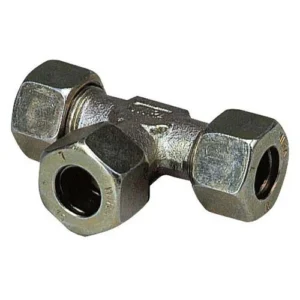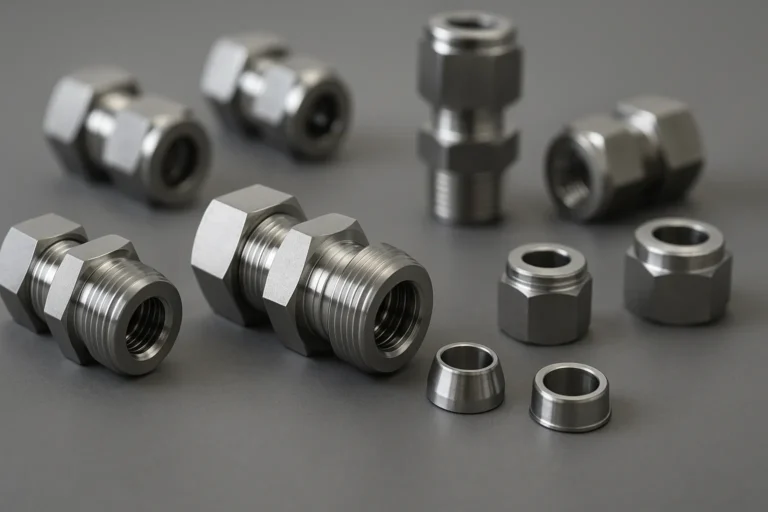Contact : +91-79045 61980 | Email: hydrofitengineers@gmail.com
How to choose the right hydraulic fittings for your machinery?

When hydraulic uptime is non-negotiable, selecting the right hydraulic fitting stops being a parts decision and becomes a performance mandate. This field guide consolidates the core due-diligence factors (pressure envelope), media compatibility, thread standards, geometry, and serviceability. So that your maintenance, reliability, and procurement teams can align on one common playbook.
As a Chennai-based solutions partner, Hydrofit Engineers supports industrial, construction, and agricultural fleets with a full-stack fitting portfolio from brass compression to stainless steel double compression and socket weld systems, engineered to mitigate leaks, control lifecycle cost, and accelerate mean time between service (MTBS).

Hydraulic Fittings - Quick Links
Calibrate to System Requirements
Start with the operating envelope. Your fitting selection should map to actual pressure cycles, fluid chemistry, duty duration, and environment. Document the worst-case scenario, not the average. That’s what protects you against unplanned downtime.
- Operating Pressure: Validate max and surge pressures. High-pressure circuits often standardize on SS socket weld pipe fittings for joint integrity.
- Fluid/Media: Match material to hydraulic oil or specialty fluids. Avoid galvanic risk and seal incompatibilities.
- Environment: Corrosive, marine, or wash-down zones justify stainless steel pipe fittings or SS double compression fittings for longevity.
- Vibration & Shock: Dynamic applications benefit from hydraulic swivel elbows/tees to reduce stress at the connection point.
Align Fitting Type to Use Case
- Brass Compression Fittings: These fittings are used at low-to-medium pressure, easy assembly, dependable sealing where temperature and vibration are moderate.
- Stainless Steel Pipe Fittings: Corrosion-resistant, structurally robust; preferred in oil & gas, marine, and heavy industrial hydraulics.
- SS Double Compression Fittings: It has dual-ferrule sealing for leak-critical, high-pressure assets.
- Hydraulic Equal Elbow / Tee / Cross: These fittings enable directional changes and branching while maintaining line balance and pressure.
- Hydraulic Swivel Elbow / Swivel Tee: Accommodate movement and rotation without loosening connections – ideal for mobile hydraulics.
- SS Buttweld Pipe Fittings: High-strength welds for vibration-intense environments and fixed plant layouts.
- SS Stock Threaded Fittings: Fast assembly/disassembly for maintenance-heavy lines.
- SS Bulkhead Union 2 / Equal Compression Tee / Equal Cross Union: Panel pass-throughs and equalized branching with high-integrity grips.
- SS Socket Weld Pipe Fittings: Proven choice for high-pressure circuits needing compact, durable joints.
Right Size, Threads, and Geometry
Misdimensioned fittings are a direct pathway to leaks, pressure loss, and asset damage. Standardize selection with a verification checklist.
- Size Matching: Confirm hose/tube OD and wall. Validate flow targets and velocity to prevent heat and erosion.
- Threads & Sealing: BSP, NPT, JIC, specify correctly and avoid cross-threading. Where applicable, leverage O-ring face seal for leak resistance.
- Angles & Layout: Use straight, 45°, or 90° geometries to match routing constraints and service access.
Material Strategy = Lifecycle Strategy
- Stainless Steel: High corrosion resistance for harsh, wet, or chemical environments. These are premium durability for long cycles.
- Brass: Cost-efficient performance in low-to-medium pressure lines; easy installation and rework.
- Carbon Steel: Strength with value for general industrial duty when corrosion exposure is controlled.
Engineer for Installable
- Quick Assembly: Compression and push-to-connect (where appropriate) accelerate install time.
- Leak Resistance: O-ring and dual-ferrule systems reduce retorque events and fluid loss.
- Modularity: Hydraulic swivel and union options enable targeted replacements without full line disruption.
Optimize Total Cost of Ownership
- Durability: High-grade SS and dual-ferrule designs cut replacements and unplanned downtime.
- Efficiency: Correct sizing and smooth routing reduce energy losses and heat generation.
- Compliance & Safety: Reliable sealing protects operators, equipment, and the environment.
Conclusion
Proper sizing of your hydraulic fittings is a quantifiable lever to uptime, safety and cost management. Align selection with the true operating envelope, deploy the correct geometry, and standardize on materials that suits your environment. With a curated range and application support, Hydrofit Engineers helps you operationalize leak-free performance and keep productivity on plan.
FAQs for Hydraulic Fittings Selection
Which hydraulic fitting material should I choose for corrosive environments?
Prioritize stainless steel in marine, wash-down, or chemical exposure zones. It delivers superior corrosion resistance and extended service intervals versus brass or carbon steel.
How do I decide between compression, double compression, and socket weld?
Compression suits low-to-medium pressure with fast install. Double compression (dual ferrule) is for leak-critical, high-pressure duty. Socket weld is favored where maximum joint integrity and compact routing are required.
What thread standards should I consider BSP, NPT, or JIC?
Match the platform standard. BSP is common in many global industrial systems, NPT is tapered and widely used in North America, and JIC provides a 37° flare for robust mechanical sealing. Avoid cross-mixing and always verify with gauges.

